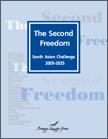Africa�€™s Time of Reckoning
|
|
SFG Research Analysts in media
Global Foresight
Paradigm Shift
Democracy and Development
Staff Article
October, 2009
By
|
Poverty, civil wars, pirates, environmental degradation, the highest number of HIV/Aids victims are some of the images conjured up when we discuss Africa. It is a land of high fertility and large families, where societies are under extreme stress and the young out number the old by almost double. The poorest region of the world, Africa rates low on the 2001 Human Development Index, where 29 of the 36 nations with the lowest human development are in Africa. The growth rate, at the lower end of the scale is 2.2 percent, as compared to the world average of 1.4 percent. In parts of Western Sahara, Niger, Uganda and Angola, fertility is the highest, with women having an average of 7 children.
Yet there is another Africa, one that is gaining ground, slowly but surely. Pockets of people around the continent have begun chartering their own course, by restraining population growth and investing in economic growth. Cities such as Addis Ababa and Accra have recorded some of the lowest fertility across the board; and in Kenya the desire for children amongst couples has dropped from 8, in the 1980s, to only 4 children in 2007. The United Nation has projected that if the trend continues, the average number of children per family could be as low as 2.5 by 2050, as compared to over 6 in 1990. Africa has started out on a demographic transition, one that could transform the continent and be a means to overcome future disasters.
Africa is following the classic trend that most regions in the world have already experienced �€“ as people are educated and get richer, they want to have fewer children. As the older generation dies and the current pool of young children grow up, it automatically increases the working age population. According to statistics, by 2020, the working age population will rise in 27 of the 32 African countries. This results in what is termed as a �€˜demographic dividend�€™, which can be used to create and sustain a fruitful cycle of growth. If the fast growing, active and eager population is effectively handled, it can enable a country to become more productive.
China, East Asia and to a certain extent India are models to follow. Similar changes in fertility and demography accounted for almost a third in East Asia�€™s economic growth and more so of China�€™s in the 1980s. As in the case with India, which is currently in the middle of attempting to reap this dividend, Africa�€™s people are its biggest asset. Thus this population bulge, at that vital age group, is an inevitable advantage and can do for Africa, what it did for Asia. But it is also important to remember that this is not an eventuality; Africa will have to choose the right policies and overcome its many problems to cash in on this dividend. If not, the large number of young will be unemployed and restless, becoming a burden on society, which could lead to a number of other problems. There is also the question of time; Africa has at the most two generations in which to follow the same path of its eastern neighbors. Once society ages and the old become dependant, the potential to tap advantageous resources is lost.
There are a number of reasons for pessimism, from the lack of food security, to climate change. On an average Africa produced less food per head, due to smaller farms, diseased crops and in many countries, mass destruction of land due to civil war. The continent needs a green revolution, along with sustained investment to combat climate change. The UN Intergovernmental Panel on Climate Change predicts that Africa will be the hardest hit�€“ forcing societies to return to subsistence techniques if population growth outpaces agricultural production. If African nations are unable to employ and feed their growing population, such a disaster will occur.
While the population growth rates might have slowed in the last two decades, with women wanting fewer children in certain countries, the overall population is still growing with little or no access to health care, rampant malaria, minimal education and unemployment. Over 22 million people in Sub-Saharan Africa alone have been diagnosed with HIV/Aids, with little or no hope for treatment. There are also the added issues of widespread political violence and civil war, neither of which is likely to be solved in a hurry. Civil war means that the demographic changes have not even begun in certain nations, such as Congo and Sierra Leone. If the growing population of young people do not get jobs, there is a possibility they will resort to violence, thus creating further unrest in societies that are at present relatively quiet.
Yet, for all these points of pessimism, there are reasons to hope, and to realize that the demographic transition can be effectively utilized. Countries such as Mauritius and Tunisia have already begun a successful transition through fertility decline, due to increased awareness, a higher standard of living and a widespread use of contraceptives. The use of contraceptives has doubled in the last 15 years, and is likely to triple over the next 15-20 years. Children in South Africa have taken matters into their own hands and begun demanding a proper education, where recently, thousands took to the streets to demand libraries and books. And in Somalia, after decades of dictatorship and chaos, a moderate leader has been elected with grassroots support within the country. Africa also has the added advantage of rapid urbanization, the fastest the world has ever seen, and the space to absorb a growing number of people coming in from towns and villages. None of the large cities with a population of over 1million are showing signs of mass starvation, and urbanization here can be seen as a benefit.
This demographic shift is not the solution to Africa�€™s problems �€“ countries need proper policies in place, money and investment, education, governments that last and a number of other things. What this transition, and the dividend it produces does, is provide the continent with an avenue upon which to embark on a path to achieve all this. It is now in the hands of the African people and their leaders to embrace this opportunity and translate it into a positive future. It is a means to an end.
Related Publications
-
.jpg&maxw=50)
Big Questions of Our time: The World Speaks, 2016
Download:Big Questions of Our time: The World Speaks _Full Report
-

-

Second Freedom South Asian Challenge 2005-2025, 2005
read more
Download:Second Freedom South Asian Challenge 2005-2025 Full Report
Related latest News
Related Conferences Reports
-

Global Challenges Conference, October 2016
Download:Global Challenges Conference Report
-

Conference on Responsibility to the Future: Business, Peace and Sustainability, June, 2008
Download:Global Security and Economy: Emerging Issues


